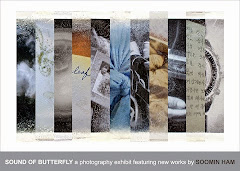Planning your FotoWeek DC schedule? Mark November 10th as a night to visit the Torpedo Factory Arts Center in Old Town Alexandria for demonstrations of two fantastic alternative photography processes by members of Multiple Exposures Gallery (MEG).
Danny Conant and Colleen Henderson kick things off on November 10th at 7:15 in the Target Gallery with image transfers using DASS Super Sauce. At 8:15, the action moves upstairs to MEG's space on the third floor where Sandy LeBrun-Evans and Louise Noakes will give a lesson on image transfers using Purell hand sanitizer.
While your calendars are out, mark one more date. On November 17th at 7:30 p.m., join MEG member Janet Matthews at Multiple Exposures Gallery for a demonstration of making cyanotypes, a 19th century process that's still used today to make unique photographic prints.
November 10
Image Transfers Using DASS Super Sauce
7:15 pm, Target Gallery at the Torpedo Factory, Alexandria, VA
Image Transfers Using Purell Hand Sanitizer
8:15 pm, MEG, Studio 312, Torpedo Factory, Alexandria, VA
November 17
19th Century Processes: Making Cyanotypes
7:30 pm, MEG, Studio 312, Torpedo Factory, Alexandria, VA
Danny Conant and Colleen Henderson kick things off on November 10th at 7:15 in the Target Gallery with image transfers using DASS Super Sauce. At 8:15, the action moves upstairs to MEG's space on the third floor where Sandy LeBrun-Evans and Louise Noakes will give a lesson on image transfers using Purell hand sanitizer.
While your calendars are out, mark one more date. On November 17th at 7:30 p.m., join MEG member Janet Matthews at Multiple Exposures Gallery for a demonstration of making cyanotypes, a 19th century process that's still used today to make unique photographic prints.
_______________________________________________________
Demonstration Schedule: November 10
Image Transfers Using DASS Super Sauce
7:15 pm, Target Gallery at the Torpedo Factory, Alexandria, VA
Image Transfers Using Purell Hand Sanitizer
8:15 pm, MEG, Studio 312, Torpedo Factory, Alexandria, VA
November 17
19th Century Processes: Making Cyanotypes
7:30 pm, MEG, Studio 312, Torpedo Factory, Alexandria, VA
______________________________________________________
Demonstration Descriptions:
Image Transfers using DASS Super Sauce
Using DASS Super Sauce solution, Danny
Conant and Colleen Henderson will demonstrate how, using your own
digital photo files, you can easily and simply make unique image
transfers onto an assortment of receptor surfaces, including artist
papers, wood panels, and a specialty paper called "DASS Stone Paper."
Image Transfers Using Purell Hand Sanitizer
Learn how to transfer your images onto beautiful printmaking papers and fabrics. You won't believe what a little hand sanitizer can do to produce this very unique visual effect.
19th Century Processes: Making Cyanotypes
Cyanotype printing is one of the easiest and safest ways to make photographs by hand. Just a few ingredients, paper, two chemicals, ultraviolet light (such as the sun) and water, are needed to create unique photographic prints. We will demonstrate the process and look at some contemporary approaches used with this historic process.














